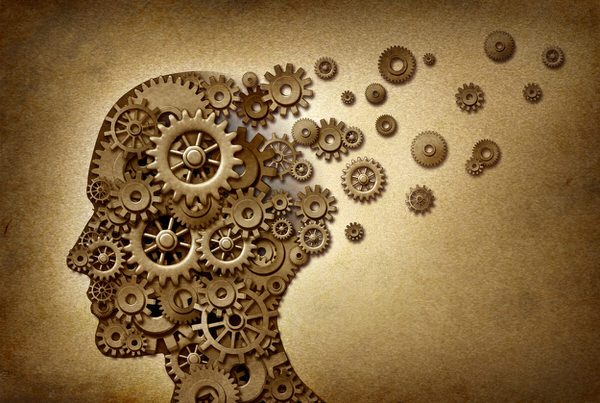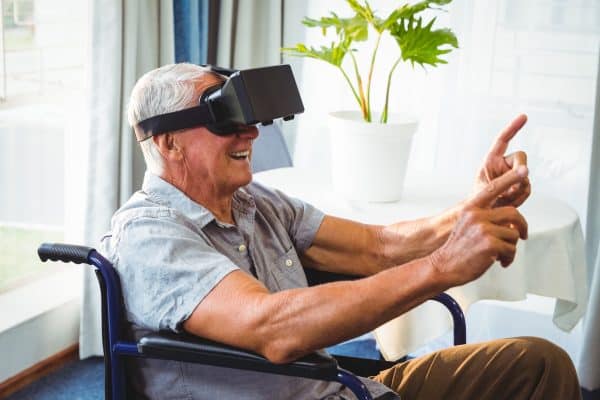Mindfulness and meditation long ago moved from Hollywood to Silicon Valley, and on to Main Street. By now you may have relegated “mindful” to a category of overused phrases like “lean in” and “deep dive.” Don’t write off mindfulness meditation just yet, however. It has the potential to address several concerns that people our age face. Like stress management, cardiovascular health and cognitive decline. Mindfulness meditation at midlife can help you thrive now and in your life’s next chapter.
Here’s a primer on what mindfulness meditation is, why you should do it and how to get started with mindfulness meditation at midlife.
Mindfulness
People toss around “mindfulness” and “meditation” interchangeably, but they are two different concepts. As explained by Lodro Rinzler, co-founder of MNDFL, a network of meditation studios, “mindfulness is the essence of bringing your mind fully to one thing that is happening in the present moment.” Thus you can be mindful while you eat your food, fold the laundry, or watch a bird outside your window.
You can cultivate mindfulness in your everyday activities without ever meditating. But meditation is a way to train yourself in mindfulness. I think of meditation as an accelerated path toward becoming more mindful — and I need all the help I can get!
Meditation
Again borrowing from Lodro Rinzler, “meditation is a revolutionary practice for transforming your life by becoming familiar with, and ultimately, befriending all aspects of who you are.” There are innumerable types of meditation practices. Some better-known ones include Buddhist traditions like focusing on the breath. There’s also Vedic or Transcendental Meditation, where a teacher may assign you a personal mantra. Another popular type is loving kindness meditation. It stems from Tibetan Buddhist teachings and often uses visualization to help you develop compassion.
People may consider meditation something they have to do while sitting cross-legged on the floor. In fact, you can meditate sitting in a chair, lying down, standing, even walking.
Meditative labyrinths
The prayer labyrinth is one such form of walking meditation. Archeologists have found evidence of labyrinths in cultures as varied as the Qing Dynasty of China, Celts and Native Americans. Medieval Christians also walked the labyrinth. In fact, many contemporary labyrinths are modeled on the one inlaid in the stone floor of Chartres Cathedral in 1201.
You can learn more about labyrinths and access the World Wide Labyrinth Locator at Veriditas. Also check out Smithsonian.com for photos and descriptions of meditative labyrinths around the world.
Mindfulness meditation at midlife
What is mindfulness meditation?
Mindfulness meditation generally refers to the Buddhist-inspired tradition of focusing on your breath. Jon Kabat-Zinn popularized this type of meditation in the US with his 8-week stress reduction classes for chronically ill patients who weren’t responding to traditional treatments. He started this program in 1979 at the University of Massachusetts Medical School. Called Mindfulness Based Stress Reduction (MBSR), it uses meditation to cultivate mindfulness in everyday life.
Kabat-Zinn defines mindfulness as “awareness that arises through paying attention, on purpose, in the present moment, non-judgmentally.” He generally separates the practice of mindfulness meditation from its Buddhist roots. Kabat-Zinn prefers that people not associate mindfulness with any particular religious tradition.
He founded MBSR within in the healthcare context. But in essence, Kabat-Zinn’s MBSR teachings have brought mindfulness meditation into the mainstream.
Why meditate at midlife?
Mindfulness meditation can reduce suffering from physical ailments that may increase at midlife. It’s also been shown to reduce stress, anxiety and depression. These conditions can reduce your mental and physical well-being at any age, but they affect people at higher rates during midlife.
To illustrate, more middle-aged women are depressed than any other age or gender group. According to the Centers for Disease Control (CDC), 12.3% of women ages 40-59 report moderate to severe depression, more than any other group studied. These rates compare to depression rates of 9.5% for all females ages 12 and over, and 5.6% for all males.
Thus, mental health issues tend to be more troublesome at midlife, especially for women. It may also be the case that by midlife, people want to try a new approach to their problems.
For example, you may have the sense that things you did before to improve your mood just aren’t working as well now. You may be more open to something like meditation. Whatever the reason, people are turning to mindfulness meditation at midlife.
Meditation’s physical benefits
Positive brain changes
A landmark 2011 study found that mindfulness meditation increased grey matter in the brain. Before and after MRIs of students in an MBSR class showed increased cortical thickness in the hippocampus. This is the region of the brain that governs learning and memory. Alongside these increases, there were decreases in the amygdala size. This is the part of the brain involved with fear, anxiety and stress. What’s more, researchers noted these changes after people had been meditating for only eight weeks.
Reduced cardiovascular risk
In 2017, the American Heart Association (AHA) released a comprehensive scientific statement called Meditation and Cardiovascular Risk Reduction. It examined claims that meditation reduces physiological stress response, blood pressure, smoking, insulin resistance, atherosclerosis and other factors associated with cardiovascular disease.
The AHA paper found modest scientific data to support meditation as a way to reduce heart disease. It noted that there have been few if any studies to compare rates of heart attack or death between meditators and control groups. And scientific standards always favor clinical trials measuring ultimate effects like mortality over proxy measures like blood pressure values or self-reported feelings. Hence the AHA’s “modest scientific data” conclusion.
Nonetheless, the AHA concludes that meditation’s benefits outweigh its costs. Its report suggests that meditation is a low cost, low-risk lifestyle intervention. As such, it can accompany other lifestyle changes to reduce people’s cardiovascular risk. Worries about cardiovascular disease often increase during middle age. But mindfulness meditation at midlife offers a way to address those worries — alongside changes in diet, exercise and so on.
Pain relief
Clinical trials have shown that mindfulness meditation provides pain relief. And it does this without engaging the brain’s opioid receptors. Which is good news for people who suffer from chronic pain. As of 2016, chronic pain sufferers made up more than 11% of the US adult population. Especially given our national opioid crisis, exploring ways to manage pain with fewer drugs is a good idea.
Mainline publications like The Atlantic have highlighted meditation’s potential to relieve chronic pain. Ongoing sufferers often turn to meditation when surgery and painkillers fail to work.
Moreover, chronic pain increases with age. For example, a study of 4000 Norwegians finds that 19.2% of younger adults (18-39), 27.5% of middle-aged (40-59), and 31.2% of older adults (60+) experienced chronic pain. Mindfulness meditation at midlife may offer relief for a condition now affecting almost one-third of people our age.
Cognitive health and longevity
A 2015 study by UCLA researchers found that meditation can reduce the negative impact of aging on the brain. This study analyzed 100 long-term meditators and control subjects ages 24-77.
Prior scientific studies have shown that the human brain begins to deteriorate in one’s mid-twenties. Thus as expected, all older participants in the UCLA study showed decline in grey matter correlated with age. However, meditators showed less steep declines than the control group.
Based on this study, meditation can slow the decline of cerebral health that one experiences with age. Connected with this benefit is the potential for slower cognitive decline and longer life overall.
Studies have demonstrated a correlation between meditation and length of telomeres. Telomeres are “protective protein caps” at the ends of DNA strands that allow cells to replicate. The longer the telomere, the more a cell can reproduce. Shorter telomeres are associated with cellular aging and reduced ability to fight off disease. Thus, longer telomeres are better. Just another reason why mindfulness meditation at midlife may help you live a longer, healthier life.
Meditation’s emotional benefits
Lower stress, anxiety and depression
This is a big one. Several of meditation’s physiological benefit claims relate to its ability to lower mental stress. Proponents say meditation reduces blood pressure, inflammation, even risk for the common cold. Not only does it yield improvement on self-reported stress measures. Studies such as this one show that meditation decreases stress hormones in the body.
MBSR addresses mental health issues like stress, depression and anxiety. For example, one frequently-cited study is a 2004 meta-analysis by members of the Freiberg Institute for Mindfulness Research. It considers sixty-four prior studies on MBSR. Researchers conclude that “MBSR may help a broad range of individuals to cope with their clinical and nonclinical problems.”
Proof of meditation’s benefits to mental as well as physical health demonstrates the mind-body connection. Meditation doesn’t just improve your mood. It helps your body fight disease better.
Better attention and focus
In a world dominated by multi-tasking, being able to focus — really focus — can give you an edge. This is exactly what UC Santa Barbara researchers found to be the case for students taking a 2-week mindfulness training course. Their GRE verbal scores increased from 460 to 520 after course completion. They also improved on tests of working memory and task focus.
Note that students’ scores went up 13% with only two weeks of mindfulness training. Based on these results, people our age can improve attention and focus through mindfulness meditation at midlife. Even if the effect you gain is smaller than in this study, improved ability to focus can help you imaintain mental sharpness as you age.
More self-control
Which one of us doesn’t wish we had more willpower? Maybe you want to lose weight, stop addictive behavior or quit losing friends over dumb stuff you say or do. Meditation offers solutions here, too.
Stanford University psychologist Kelly McGonigal wrote a book called The Willpower Instinct: How Self-Control Works, Why It Matters, and What You Can Do to Get More of It*. Based on her popular Stanford Continuing Studies course, the book discusses the science of self-control. It explores how meditation produces brain changes that allow you to exercise greater calm and self-control.
Increased compassion
The type of meditation most known for increasing compassion is loving-kindness meditation. Coming from Tibetan Buddhist traditions, this type of meditation involves visualizing other people and sending them warm wishes.
While different from mindfulness meditation, loving-kindness meditation is worth mentioning when listing potential meditation benefits. It can help you develop self-compassion, something many of us lack. It also helps increase empathy and cultivate positive emotions toward others.
How to start mindfulness meditation at midlife
Depending on your location and schedule, there are lots of options for learning to meditate. You might want to try a couple of different things — don’t give up if your first efforts fall flat.
MBSR classes
Many health clinics and community organizations offer Mindfulness Based Stress Reduction, the 8-week program developed by Jon Kabat-Zinn. Demonstrated to reduce anxiety disorders and address health issues like chronic pain, MBSR has a proven track record. If you need help finding a class near you, consult the U Mass Center for Mindfulness.
Another option would be to take an MBSR class online. U Mass offers online classes for tuition on a sliding scale. You also can search for other online offerings via the web.
Local meditation classes
Many localities have organizations or studios that teach meditation. If you decide to go this route, make sure to investigate beforehand. Talk with students of the program, and see if you can do a trial class.
Beware of cult-type organizations. Meditation is not exclusive to any particular religion. It also doesn’t require that you ascribe to a specific set of beliefs or a stated way of life.
Books, DVDs
For an introduction to mindfulness as a concept, try one of Kabat-Zinn’s books. His most famous is Wherever You Go, There You Are: Mindfulness Meditation in Everyday Life*. Another popular one is Full Catastrophe Living: Using the Wisdom of Your Body and Mind to Face Stress, Pain, and Illness*. You can also check out his audiobooks and other recordings of guided meditations.
There are lots of other practitioners who offer guided meditations you can stream online or download for offline use. See what appeals to you.
Apps
Using a phone app is my favorite way to learn meditation. In fact, my next post will review top meditation apps you can download on your iPhone.
I really like the app approach because I can practice meditation on my own schedule. And most apps track your progress in some form or another, which makes them kind of fun. Here are two of my favorites:
A trend to try
Sure, mindfulness meditation is trendy. It’s probably been trendy for so long that true trendsetters consider it passé. There are also people who dismiss anything popular as lacking in substance. For example, when I told my mom I’d started meditating, she replied, “Yes, I tried meditation a while back. I got over it.”
But I think meditation’s worth a try. Or even a second try, if your first one didn’t work out. Meditation can lead to improved mental and physical health. And it costs mainly your time, say ten or twenty minutes a day. Time when you otherwise might be watching TV or browsing junk email.
Other startup costs include books, DVDs or an online subscription, but they don’t add up to much. Especially if you weigh them against potential benefits to your well-being. Better health will translate into fewer doctor and therapist appointments over the long term.
In summary, give mindfulness meditation at midlife a try. Stay tuned for the next post on my favorite meditation apps. But in the meantime, start exploring modern applications of this ancient path to better health.
Images via: Shutterstock, Flickr, PxHere









